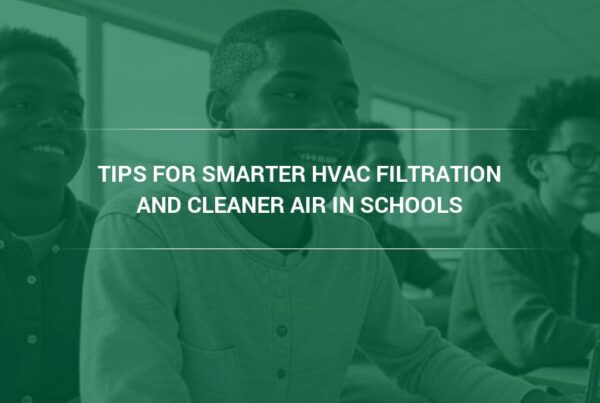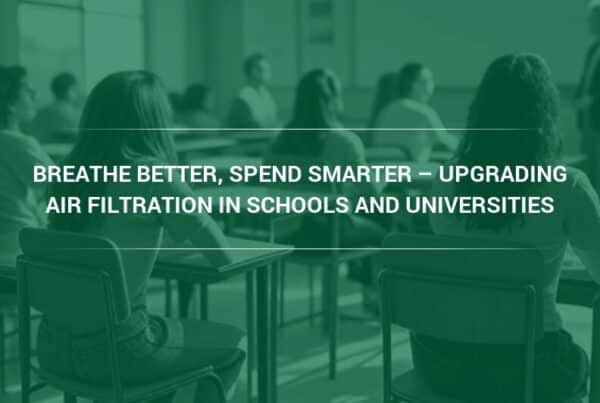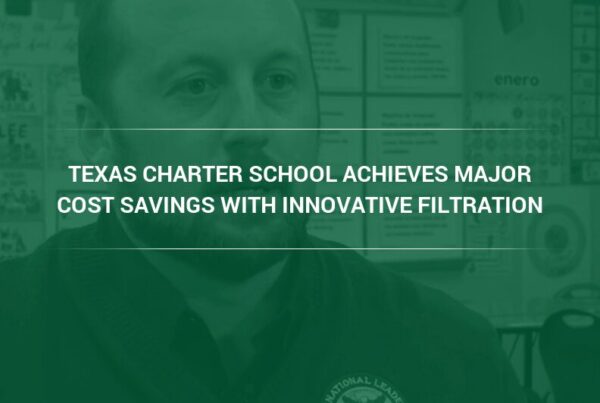Schools, colleges and universities continue implementing policies to operate in the safest way possible as the COVID-19 pandemic continues. The most often used strategies to prevent COVID-19 outbreaks are encouraging or requiring vaccination, wearing masks and social distancing. But evidence shows that upgrading ventilation and filtration to improve air quality is another crucial tactic in fighting the spread of the virus. In fact, American Rescue Plan (ARP) funds are available to help with these costs.
Key CDC Recommendations for Schools and Higher Ed
As pandemic conditions change, the Centers for Disease Control and Prevention (CDC) alters its guidelines to address public health concerns. In general, the agency advocates COVID-19 vaccinations as the top strategy to reduce the spread of the virus and to continue in-person learning and extracurricular activities at K-12 schools. In addition, the CDC recommends school officials use a multilayered approach to combat disease transmission. This includes indoor masking by students, teachers and visitors. The CDC’s guidance to higher education administrators is a similar mix of mitigation tactics.
The agency also encourages maintaining at least three feet of physical distance between students within classrooms. Additional tactics include testing for the virus when feeling ill or if exposed, handwashing, respiratory etiquette, staying home when sick, and cleaning and disinfection.
The CDC notes that improving indoor air quality (IAQ) with proper ventilation and filtration also helps to keep schools safe. Specifically, a July 2021 CDC report shows that HEPA filters can reduce exposure to the virus that causes COVID-19.
Experts stress that schools should not invest in surface cleaning at the expense of cleaning the air. “Surface cleaning isn’t very useful in terms of bang for the buck in COVID-19,” said Delphine Farmer, an aerosol expert at Colorado State University. “If nothing else, cleaning solutions can fill the air with a complex cocktail of toxic chemicals.” Regarding systems that use chemical processes that target certain airborne organisms, Farmer says these methods can produce a series of organic compounds, including toxins such as formaldehyde. “What we know works is ventilation and filtration.”
“The layered approach covers known methods for slowing transmission of the virus,” says air filtration expert Mark Davidson, Manager of Marketing and Technical Materials at Camfil USA. “Efficient ventilation and filtration are an important part of the plan because the virus is most often spread airborne through respiratory droplets and aerosols.”
EPA Guidance
To help combat the spread of COVID-19 in schools, the EPA focuses on creating healthy indoor environments. It provides guidance and resources to help administrators and facility operators in creating and maintaining IAQ in learning environments. These include a web page dedicated to Creating Healthy Indoor Air Quality in Schools and an IAQ Tools for Schools Action Kit.
The agency advocates implementing engineering controls, administrative controls and space reconfiguration designed for the specific building and situation to address COVID-19 in public indoor spaces.
The EPA says important engineering controls include:
- Increasing ventilation with outside air,
- Improving filtration of air recirculating throughout the building to remove as many airborne particles as possible, and
- Adjusting or reconfiguring airflows to minimize indoor airborne transmission of the virus.
The Difference Between Ventilation and Filtration
Building ventilation is the process of pulling in fresh outdoor air and/or pushing out stale or contaminated indoor air. Natural ventilation moves the air using non-mechanical forces like wind and is achieved by opening windows and doors to the outside. Mechanical ventilation may draw in outside air through heating, ventilating and air-conditioning (HVAC) systems using ducts and fans.
An important factor in efficient ventilation is maintaining adequate airflow. A common way to evaluate ventilation is to measure how often the indoor air in a space is totally replaced. This measurement is known as air changes per hour (ACH). According to the Rhode Island Department of Health, in a 30-foot-square classroom with 25 students in it, the air should be replaced at least every 15 minutes, which equals an ACH of 4. If the air is replaced at least every 10 minutes, the ACH jumps to 6, which is better because a higher ACH lowers the risk of disease spreading through the air.
Air filtration complements ventilation by capturing airborne contaminants through air filters. This process cleans the air before it is returned to the indoor environment. There are many types of specialized air filters designed to capture different kinds and sizes of particulates. Airborne particulate matter (PM) is characterized by its size in microns. As a reference, a single micron is one millionth of a meter and one inch is 25,400 microns in length. A person with good eyesight may be able to see a 20 micron particle under the right conditions. The most typical airborne contaminants are:
- PM 1 particles <1 μm in size, such as viruses, bacteria and other pathogens that can cause infections and disease,
- PM 2.5 particles <2.5 μm in size, such as pollen, spores, allergens and other organic particles,
- PM 10 particles <10 μm in size, such as coarser fine dust and organic particles, and
- Coarse particles 10 μm or larger, such as visible coarse dust, sand, leaves, hairs and other large organic particles.
It is important for facility operators to consult with an air filtration expert to make sure the building’s air filters are designed to capture large, small, nuisance and hazardous particles.
“Well-designed ventilation and filtration go hand in hand to create good indoor air quality,” Davidson says. “Even the best HVAC systems won’t clean the air if they don’t include the right air filters that have been installed correctly to handle the job.”
How Ventilation and Filtration Improve Air Quality
Efficient ventilation is an important COVID-19 transmission prevention strategy. Introducing fresh outdoor air into a building helps disperse virus particles. Education facility managers can improve ventilation by:
- Opening doors and windows (if this can be done safely),
- Using child-safe fans to increase the effectiveness of open windows, and
- Adapting HVAC or air filtration systems.
However, ventilating schools with recirculated air is not a comprehensive strategy to reduce COVID-19 transmission unless the air goes through an air filter designed to capture small particles. A minimum efficiency reporting value (MERV) rating is used to characterize how well an air filter removes different-sized particles in the air. The American Society of Heating, Refrigerating and Air-Conditioning Engineers (ASHRAE) recommends a minimum filtration efficiency target of MERV 13.
If the air filter has a MERV 13 rating or higher after being tested, it is rated to capture at least 90% of the largest particles used in the test. This range of particles is between 3.0 and 10.0 microns and is the size of many virus-containing aerosols found in the air. The highest MERVvalue is 16 which is rated to capture up to 95% of all particles used in the test over 0.3 microns. High-efficiency particulate air (HEPA) filters are better at filtering the smallest infectious airborne particles than MERV 16 filters. A HEPA air filter captures a minimum of 99.97% of 0.3 micron particles..
Another consideration affecting MERV ratings is electrostatically charged filter media, which behaves similar to a magnet to attract particulates. These air filters can be effective because they have high MERV values, but this value is only accurate when the filters are newly installed. As the charged filter media captures more and more particulates, the electrostatic charge loses its ability to attract particles. As a result, the MERV value drops. For example, a new electrostatic MERV 13 filter can drop to the equivalent of a filter with a MERV 8 rating within a short period of time.
To clarify this situation, the ASHRAE 52.2 committee who originally devised the test standard to assign MERV values based on performance, published an optional testing method for determining air filter efficiency without electrostatic charge. These ratings are referred to as MERV-A values. To distinguish between MERV and MERV-A, think of the “A” as “actual” efficiency. Education facilities should insist on MERV-A ratings to ensure optimal performance for the lifetime of the air filter.
Viruses captured in an air filter operating within rated specifications will not release back into the airstream, according to Camfil experts. This is because viruses encapsulated in an aerosol or droplet are contained within the air filter and are strongly mechanically bound to the fibers in the filter media. Once the virus is captured, it will stay in the air filter and eventually dry out, die and become inactive. Many studies on the COVID-19 virus indicate that the virus does not survive longer than three days on open surfaces under ideal conditions..
IAQ Improvements Needed in Schools, Colleges and Universities
The COVID-19 pandemic has brought much-needed awareness to the state of ventilation and air filtration in educational facilities around the country. A 2020 national survey of school districts by the United States Government Accountability Office (GOA) shows that about 54 percent of public school districts need to update or replace multiple building systems or features in their schools. Approximately 41 percent of districts need to update or replace HVAC systems in at least half of their schools. The survey also highlights that most states do not conduct assessments to determine school facilities’ needs, leaving the job to school leaders.
Poor IAQ in schools increases the potential for long-term health problems among students and staff. It also negatively affects student comfort, the learning environment and attendance. And it reduces the productivity of teachers and staff due to discomfort, sickness or absenteeism.
The U.S. Department of Education acknowledges that even before the pandemic, many schools, colleges and universities had IAQ challenges. This leaves many schools and higher education leaders all the more challenged in opening schools for in-person learning.
“Determining the best HVAC and filtration systems in educational facilities is challenging—even without the pandemic,” Davidson explains. “That’s because there are multiple environments to consider like classrooms, gyms, dining areas, labs, libraries, hallways, offices and living spaces.”
Fortunately, ARP funds can be used to improve IAQ, ventilation and air filtration. This includes mechanical and nonmechanical heating, ventilation, and air-conditioning systems, filtering, purification and other air cleaning, fans, control systems, and window and door repair.
A recent study of spending plans of schools receiving funds from the Elementary and Secondary School Emergency Relief program shows that more than half the school districts and charter schools surveyed plan to spend on improving HVAC systems. These expenditures range from procuring better air filters for existing units to replacing underperforming systems.
Ventilation and Air Filtration Solutions to Reduce COVID-19 Transmission
Preparing safe in-person learning spaces during the COVID-19 pandemic in most cases will require improvements or changes to building ventilation and air filtration systems. Because educational facilities vary in age, complexity, HVAC equipment and building automation systems, ASHRAE offers technical resources to adapt HVAC systems to improve IAQ and slow the transmission of COVID-19.
According to the CDC, the particle size of the COVID-19 virus (also known as SARS-CoV-2) is around 0.1 micrometer (µm), but is contained within larger respiratory droplets and aerosols.As noted above, ASHRAE recommends a minimum filtration efficiency target of MERV 13. However, greater filtration sometimes can lower the performance of an HVAC system because it can increase the pressure drop across the air filters, so consulting with an HVAC filtration expert is recommended.
If MERV 13 or higher air filters cannot be installed due to HVAC system constraints, ASHRAE suggests:
- Increasing the unit’s filtration maximum available level,
- Providing a recirculation fan filtration unit and duct into the return of units, or
- Using a HEPA air filtration unit that recirculates air within the space.
Portable HEPA air filtration units do not draw outdoor air into the building, but they do clean the air within an indoor space. They are powered by a fan system and can reduce the concentration of airborne particulates, including COVID-19. The unit should be the right size for the space, which is based on the airflow through the unit measured in cubic feet per minute (CFM).
Air Cleaning Technologies That Do More Harm Than Good
Experts advise against using unproven technology to clean the air. Though slick marketing makes some of these options sound viable, they can actually cause contaminated air. These unproven technologies include:
- Fogging and misting systems that use dangerous chemicals,
- On-the-spot ultraviolet light systems, and
- Disinfecting “robots.”
Camfil HVAC Filtration Solutions
With decades of experience in critical air filtration systems in many industries and applications, Camfil’s knowledge and expertise are important resources when determining the best air quality solutions for schools, colleges and universities, especially during this pandemic.
When developing a ventilation and air filtration plan to mitigate the spread of the virus, a comprehensive strategy is to put systems and air filters in place that have the greatest likelihood of capturing droplets and aerosols.
In addition to using MERV 13-A to MERV 16-A rated filters in the HVAC system, facility managers can add extra protection by installing an upstream prefilter of a lesser MERV rating. For example, a Camfil 30/30® Dual 9 (MERV 9A) can be used as a prefilter followed by a Durafil® ES2 filter at MERV 13A or higher.
For additional localized protection, or where the HVAC system cannot accommodate higher MERV-rated filters, consider installing standalone air purifiers as supplemental filtration. Camfil’s City M air purifier uses both a HEPA air filter and a molecular gaseous contaminant filter. Each unit provides up to 256 CFM of clean air, ideal for an indoor space of 20 square feet or smaller. The specially designed HEPA filters for the City M air purifier capture airborne particulates such as viruses, dust and pollen from the airstream. These air filters are 99.995% efficient against even the smallest contaminants, including the COVID-19 virus.
“Using multiple air filtration methods is an effective way to provide additional layers of transmission risk mitigation at educational facilities to help keep students, faculty and staff healthy,” Davidson adds.
About Camfil Clean Air Solutions
For more than half a century, Camfil has been helping people breathe cleaner air. As a leading manufacturer of premium clean air solutions, we provide commercial and industrial systems for air filtration and air pollution control that improve worker and equipment productivity, minimize energy use, and benefit human health and the environment. We firmly believe that the best solutions for our customers are the best solutions for our planet, too. That’s why every step of the way – from design to delivery and across the product life cycle – we consider the impact of what we do on people and on the world around us. Through a fresh approach to problem-solving, innovative design, precise process control, and a strong customer focus we aim to conserve more, use less and find better ways – so we can all breathe easier.
The Camfil Group is headquartered in Stockholm, Sweden, and has 33 manufacturing sites, six R&D centers, local sales offices in 30 countries, and about 4,800 employees and growing. We proudly serve and support customers in a wide variety of industries and communities across the world. To discover how Camfil USA can help you to protect people, processes and the environment, visit us at www.camfil.us/



